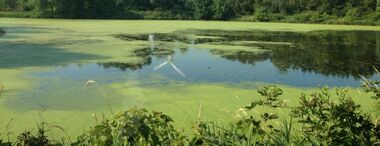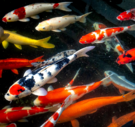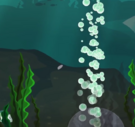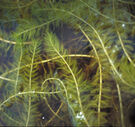Feb
08

Nature’s Pond has worked in conjunction with Steve Fender of Fender’s Fish Hatchery, author of “Farm Pond Management” and top pond and fish expert, to help you get to know your weed and algae problems. Use this as a tool to identify the various types of aquatic vegetation that exists in your ponds.
There are several types of vegetation that any pond may have. Floating vegetation, such as algae, and submerged weeds come in dozens of sizes and shapes. These types of aquatic vegetation can make your pond look and smell bad and are undesirable for fishing and swimming. The first step in deciding what type of treatment your pond requires is to identify which types of algae and weeds exist in your water.

- Algae will be a brownish color or light green slime like Filamentous Algae. It can be a fine filamentous matt or a very coarse horse hair like fibre and anything I between. Algae has no root system and free floats on the surface of water.
- Planktonic Algae, also known as algae blooms will come in a variety of colors: light green like this picture, dark green, dark like coffee, and brown. The water turns a murky green or brown color and the algae in this case is microscopic.
- Chara is a form of algae that grows from the bottom. It has a musky odour and feels gritty when crushed between your fingers. It will be a yellowish green colour.
- American Elodea is a submersed weed that is common throughout North America. It will have a root system and growth will be the best in the warmer months, but it will grow in cold water also just not as fast.

- American Pondweed: this plant is American pondweed. It has a long narrow leaf, and the leaves float on the surface of the water. The leaves are attached to a thin vine-like stem.
- Brittle Naiad will be found growing in clumps. It will have long pointy stem like leaves. The plant is brittle and will crumble easily. It also has a root system.
- Duck weed is a fast-growing surface vegetation that will have two or three tiny leaves and a single root. It will be about one-eighth inch in total size.
- This is an arrowhead plant, so named because the leaves are shaped like arrowheads. These plants grow around the edge of ponds partly in the water and on the bank ranging from one to three feet in height.

- This is smart weed. Smart weed will grow around the edge of the water and sometimes partially in the water. It is found mostly in the Midwest.
- This plant is Coon Tail, named for the way the plant is shaped like a raccoon’s tail. Coon tail is a submerged weed growing nearly everywhere in North America. A very fast growing weed, it will be fastened to the bottom of the pond with a small root system.
- Watermeal is a little seed like plant that will grow to make a very dense surface cover sometimes becoming so thick that it will block the sunlight to the underlying vegetation and killing it. In turn, it will cause an oxygen depletion which causes a fish kill Watermeal reproduces by forming a new plant from itself every twenty-four to forty-eight hours.
- Curly Leaf is a very fast growing weed that will choke out a pond in short order. It is a rooted-in weed.
- Both Water Lilies and Cattails can be useful plants. The water lilies will grow a big flower and the flowers will have an assortment of colours and provide cover. The cattails are helpful in attracting wildlife as they provide cover. However, if these plants are not controlled, they can take over.
If you are interested in more information on dealing with algae and weeds, download Steve Fender's free eBook on Pond Management! (A $19.95 value)
All photos and information for this article have been provided by Steve Fender of Fender’s Fish Hatchery since 1956, Baltic, OH, the largest and oldest fish hatchery in the Midwest. Visit www.fendersfishhatchery.com for more.
Share this article






